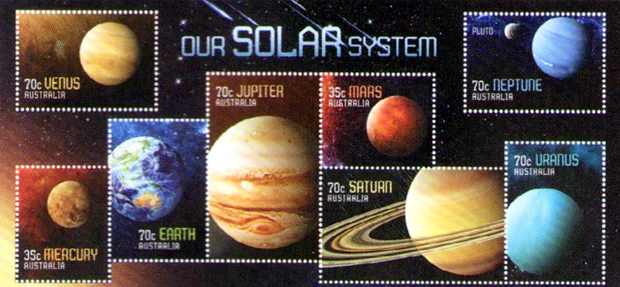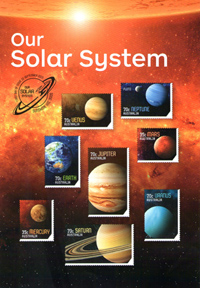

September 27, 2015
by Graham Coombe
Nanango Stamp Club
October is Stamp Collecting Month, and Australia Post always marks the occasion by releasing a special set of stamps to encourage the hobby of stamp collecting.
This year’s stamps will probably excite anyone interested in stamp collecting, young or old.
The theme of this year’s set, which were released on September 22, is “Our Solar System”, with each stamp depicting one of the eight major planets (plus Pluto, which used to be graded as a planet but is now regarded as a dwarf planet).
This is very timely, considering the world only got its first close-up glimpse of Pluto – courtesy of the New Horizons spacecraft – in July this year.
The stamps can be purchased at South Burnett post offices in a range of options:
- A stamp pack which not only has one of each of the stamps in the set, but also contains a miniature sheet of the whole set combined
- Blocks of individual stamps in the set
- First day covers, and…
- Postcards
For those who collect coins or medallions, there is also a prestige medallion cover that features a special medallion with a circle of planets that actually spins around the centre!
Stamp collecting as a hobby is not only fun, but it’s also educational.
And this year stamp series is a great example, showing the planets Mercury, Venus, Earth, Mars, Jupiter, Saturn, Uranus and Neptune (together with Pluto).
Here are a few facts you may not have known:
- The Sun, which dominates our solar system, makes up 99.8% of the total mass of the entire system.
- The eight major planets are divided into two groups: the smaller, rocky planets of the inner system and the massive gas giants that lie beyond the asteroid belt
- Mercury, nearest to the sun, is the smallest of the planets and is less than 5,000km in diameter
- Jupiter, the largest planet, is mostly a huge ball of hydrogen and helium gas, but is thought to contain a small rocky or icy core. It has a diameter of 141,000km
- In comparison, Earth, the largest of the rocky planets, is only 12,742 km in diameter
- Venus is a hellish planet with crushing atmospheric pressure, high temperatures and acid rain
- Mars is about half the size of Earth and a day on Mars is around 40 minutes longer. But Mars takes 687 days to orbit the sun, so a Martian year is almost twice as long as an Earth year
- Temperatures on the surface of Venus reach 462°C whereas the temperatures on Mars range from -87°C to -5°C
- Saturn, with its complex rings, rotates in only 10 hours and 39 minutes, but takes 29.45 years to orbit the sun
- Uranus was the first planet to be discovered by telescope (in 1781), but is unusual as it is tipped on its side as a result of an ancient impact
- Neptune (discovered 1846) and the dwarf planet Pluto (1930) were originally found as a result of mathematical calculations, because they are so far from they Sun they were difficult to see through telescopes
You can find out a lot more about stamps and stamp collecting by contacting Nanango Stamp Club, the South Burnett’s affiliated member of the Queensland Philatelic Council, which is the official body representing Queensland’s stamp collectors.
The club normally meets on the second Saturday of each month at 94 Burnett Street, Nanango from 10:00am, and the meeting is followed by a social lunch. Visitors are most welcome.
For details of the next meeting, or to contact the club to find out more, phone the Secretary (Cornelia) on 4169-0256. Nanango Stamp Club is also proudly sponsored by Heritage Bank Nanango.
























